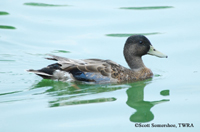Please don't Feed the Waterfowl
Feeding waterfowl may create a variety of problems for the birds and the environment. The notion that waterfowl cannot survive without human intervention is false. Ducks and geese have survived for thousands of years without handouts and many species of waterfowl are thriving today. In fact many of our urban parks are now over-populated with ducks and geese. Please enjoy local waterfowl, but view them from a distance and give them the best chance of survival by not feeding them.

Reasons Not to Feed Waterfowl
1. Feeding waterfowl can quickly lead to overpopulation problems at small urban and suburban parks.
Ducks and geese occupy areas that provide sufficient natural food. When local resources are low or depleted, individuals will move to find new food resources. Increasingly, our urban and suburban parks are home to year-round resident populations of waterfowl that remain static because of the endless food supply provided by well-meaning humans. Many of our parks are plagued with sick and injured ducks that are a direct result of the intensive aggression and competition that occurs when waterfowl populations become too large. Female mallards in urban areas often build their nests far from a water source, sometimes more than a mile away. This is a direct response to their inability to successfully incubate and raise young in our overpopulated parks.
2. Feeding waterfowl can lead to severe habitat degradation.
Human supplied food resources quickly attracts concentrations of waterfowl beyond what the natural ecosystem can support. Large concentrations of waterfowl can greatly reduce water quality and denude areas of vegetation. Concentrating large populations of waterfowl into small urban, city, and county parks is not a sustainable strategy. As numbers increase, natural forage will decrease and individuals will only become more dependent upon handouts.
3. Feeding can cause waterfowl to lose their natural fear of humans.
For many wild animals survival is contingent upon maintaining a healthy fear of humans. Feeding waterfowl can quickly cause them to lose their sense of fear and puts them at greater risk. While the food providers may have the best of intentions, the ducks still have to survive in a world filled with hazards. On an urban landscape full of dogs, cats, cars and people, the duck or goose that maintains its innate "wildness" ultimately has the best chance for survival.
4. Feeding waterfowl can lead to dietary and nutritional problems for the birds.
The age-old practice of feeding ducks and geese stale bread, pastries, cookies and various other assorted types of junk food can cause significant health problems for the birds. Even if the food is fresh, the highly processed foods provide little or no nutritional value and may actually contribute to starvation among waterfowl. Spoiled and moldy foods can impact their health just as it does for humans. Ducks and geese are far better off building their reserves by moving from location to location in search of a healthy natural diet than they are living on foods that we would never consider feeding to our children or our pets. Although all feeding is discouraged, for those who insist anyways it is far preferable to feed foods consistent with a natural diet such as cracked corn or game bird chow.
5. Feeding waterfowl can lead to disease among waterfowl populations.
Feeding of waterfowl can lead to aggressive behavior towards humans especially among geese. Unconsumed bread and other "human foods" remain on the ground as nothing more than unsightly litter. Finally waterfowl habituated to human handouts are more likely to take up residence and less likely to be successfully driven away from locations such as golf courses where they may not be welcomed by the human occupants. When such conflicts occur, it is inevitably the wildlife that loses in the end.
*This document is based on an article entitled "Feeding Waterfowl" by the Audubon Society of Portland.

















